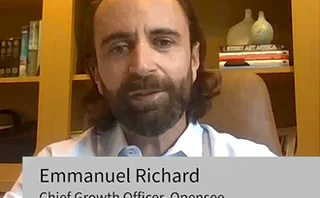Dutch asset manager turns to decision trees for currency predictions
APG has improved prediction accuracy for G10 currency movements after adopting decision tree-based machine learning.

Decision trees are among the more popular applications of machine learning in the capital markets. Uses include finding patterns in request-for-quote (RFQ) datasets and predicting stock prices. Decision trees employ a tree-like model to map out decisions, or “nodes,” and the probabilities of consequences branching out from these nodes, to work through a database and calculate outputs.
Amsterdam-based pension fund APG Asset Management, with $690 billion in assets under management, is using decision tree-based machine learning to predict the movement of G10 currencies.
“We are making predictions on currencies using market data, economic data, and fundamental data. For example, we are trying to predict if in a week or a month, how different currencies are likely to go up and down,” says Luiz Felix, expert portfolio manager at APG.
Besides economic and market data, APG also uses predictions arrived at using nowcasting—predicting the present or the very near-term future—among the inputs into its machine learning model for forecasting future currency movements. He says his team uses principal component analysis (PCA) to streamline lots of daily economic data to use in nowcasting for different regions.
“The decision trees are what are called supervised learning methodologies. In the case of nowcasting, the PCA is an unsupervised learning methodology, which tries to find commonalities from lots of data. So, the PCA is quite a different animal from the tree models,” Felix says.
Nowcasting can help a researcher understand the dynamics of local economies. “Nowcasting utilizes the evolving set of macro data available through the month and on a real-time basis, adjusts our understanding of the economic cycle in different countries,” he says.
It does this by using two sets of data. One is macroeconomic releases, such as the Purchasing Managers’ Index, which is used to indicate economic trends in manufacturing and service industries; and inflation and employment figures. The second dataset is the expectations of economists about those figures.
“Economists are also changing their forecasts about those economic releases daily. And by tracking both the realized data and the forecasts, we produce our nowcasting,” Felix says.
Analysts have to manipulate the data series that goes into the machine learning methodology. “You want to do data preparation to embed expert knowledge. You don’t want to simply get raw data, throw it at the machine learning methodology, and hope that the algorithm will actually pick up a signal. You want to input data series that more explicitly represent the signals you will be using,” he says.
The decision tree-based methods APG uses to predict the future movement of the currency in a week or a month include random forests, which combine the output from multiple independent decision trees to arrive at the final output. Another technique it is uses is XGBoost, a fast approach to gradient-boosting decision trees—a method that includes an ensemble of trees, where each new tree corrects the error of the previous tree.
“You need to spend a lot of time defining well your predictors in a way that will help the machine learning methodology to find information rather than noise for making its predictions. Sometimes, as in the case of nowcasting, we would build a model that precedes the machine learning model to be able to apply it,” Felix says.
Previously, the fund employed quantitative methods, such as rank and regression-based models, without using machine learning. The firm still uses these methods alongside machine learning.
“Typically, the machine learning predictor enters the set of existing models that we have, as an additional predictor for the strategy. So it does not replace [other predictors], but it is used as a complement to the existing methodology. And we still believe that the previous methodology was OK. But investment strategies need to evolve. Marginally we are adding new predictors to this methodology, so it can keep producing returns. But it’s not a matter of replacing it; it is a matter of actually making the strategy more robust,” Felix says.
To arrive at a final score for its currency predictions, Felix says his team will “linearly combine the position sizes suggested from the machine learning-based predictor with the ones coming from our original methodology.”
Using tree-based methodology has improved the prediction accuracy. “The machine learning approach for currencies has, on average, increased prediction accuracy by roughly 10% within our out-of-sample period, including its live period,” Felix says. Out-of-sample is a measure of how accurately a model can make predictions for new data.
A journey of trial and error
Felix, who has been with APG since 2008, has been investigating use cases for machine learning at the firm for several years. The asset manager has explored applications such as forecasting economic fundamentals, portfolio construction using deep learning, and translating central bank communications using natural-language processing.
However, some applications, while the model may have worked, have no direct trading application. For example, in the central bank use case, Felix says it could not find value in exploring it for trading activity.
Felix sees scope for extending the tree-based machine learning to other asset classes such as equities or fixed income. “If there was another portfolio manager within the organization who could make that choice [to adopt machine learning], they could use the technology put in place to make their own test and eventually come up with a model that works for them. So right now, we are thinking of making such a [machine learning] tool available to others so they can experiment and find other use cases,” he says.
Further reading
Only users who have a paid subscription or are part of a corporate subscription are able to print or copy content.
To access these options, along with all other subscription benefits, please contact info@waterstechnology.com or view our subscription options here: http://subscriptions.waterstechnology.com/subscribe
You are currently unable to print this content. Please contact info@waterstechnology.com to find out more.
You are currently unable to copy this content. Please contact info@waterstechnology.com to find out more.
Copyright Infopro Digital Limited. All rights reserved.
As outlined in our terms and conditions, https://www.infopro-digital.com/terms-and-conditions/subscriptions/ (point 2.4), printing is limited to a single copy.
If you would like to purchase additional rights please email info@waterstechnology.com
Copyright Infopro Digital Limited. All rights reserved.
You may share this content using our article tools. As outlined in our terms and conditions, https://www.infopro-digital.com/terms-and-conditions/subscriptions/ (clause 2.4), an Authorised User may only make one copy of the materials for their own personal use. You must also comply with the restrictions in clause 2.5.
If you would like to purchase additional rights please email info@waterstechnology.com
More on Data
Deutsche Börse democratizes data with Marketplace offering
Deutsche Börse Group is set to unveil its Marketplace, a one-stop data shop designed to simplify and streamline data acquisition and consumption for its clients, while also surfacing data from across the firm to its own users. Jan Stiebing and Sven…
Real-time and historical market data: Priorities, preferences and the cloud
This paper, commissioned by LSEG, focuses on firms’ current market data priorities, the asset classes and geographies they are looking to focus on in the near future, and the benefits they can expect by moving their historical market data storage and…
Hunting for reliable low latency, HFTs look to novel techs in 2023
WatersTechnology looks at advancements in market data latency technology and what role the cloud can play.
One day, all data will be delivered this way
It wasn’t long ago that, for large numbers of capital markets firms, the de facto data consumption model was DIY, or a do-it-yourself proposition, due to the scarcity of relevant managed data services on the market. Now, firms on both sides of the…
ASX, SGX earnings driven by diversified revenue
After the Chess disaster, ASX focuses on rebuilding confidence, while SGX continues investing in its derivatives business. Meanwhile, HKEx mulls data play.
IMD & IRD Awards 2023 winner's interview: Opensee
Opensee won the best risk data aggregation initiative in the annual IMD & IRD Awards for the second consecutive year, thanks to its Opensee Enterprise offering.
Fenics Market Data’s secret source
The ability of capital markets practitioners to make judicious business and investment decisions is directly determined by the quality of data underpinning those decisions. Fenics Market Data’s Rich Winter discusses the benefits of sourcing data from…
A Fireside Chat with FactSet's Jason Pangretic and Maurice Iragorri
Jason Pangretic and Maurice Iragorri discuss data and analytics, the critical role EMSs play across the buy side, and system integration and interoperability.







